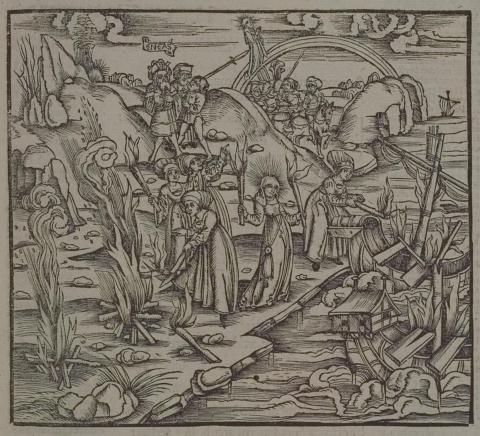Annotations
In the upper middle of the image, the goddess Iris stands on a rainbow, one of her attributes; she appears to be leaving the scene of a turmoil that Juno inspired her to create among the Trojan women (604-620). These women, in the foreground, have set fire to some ships (654-62); they have built several fires on the shore in order to light their torches. In the midst of the women, Iris, disguised as one of them, but distinguished by a glowing halo, holds two torches. One woman, Pyrgo, attempts to persuade the others that their antagonist is an immortal sent for mischief, but the rest do not listen to her (644-53). The two ships drawn to represent the fleet are broken, and are nearly engulfed in flames. Behind the women, to the left of Iris, Aeneas hurries down a hill to the shore, having been alerted of the trouble by Eumelus (664-6), who is probably the distressed young man to the right of Aeneas. King Achates, unlabeled, accompanies them. Ascanius also races to the camp on his horse, followed by some of his troops from the Trojan games, which have just been finished (667-9; 673-5). (Katy Purington)
Woodcut illustration from the “Strasbourg Vergil,” edited by Sebastian Brant: Publii Virgilii Maronis Opera cum quinque vulgatis commentariis expolitissimisque figuris atque imaginibus nuper per Sebastianum Brant superadditis (Strasbourg: Johannis Grieninger, 1502), fol. 245r, executed by an anonymous engraver under the direction of Brant.


Sebastian Brant (1458-1521) was a humanist scholar of many competencies. Trained in classics and law at the University of Basel, Brant later lectured in jurisprudence there and practiced law in his native city of Strasbourg. While his satirical poem Das Narrenschiff won him considerable standing as a writer, his role in the transmission of Virgil to the Renaissance was at least as important. In 1502 he and Strasbourg printer Johannes Grüninger produced a major edition of Virgil’s works, along with Donatus’ Life and the commentaries of Servius, Landino, and Calderini, with more than two hundred woodcut illustrations. (Annabel Patterson)